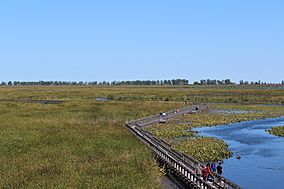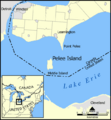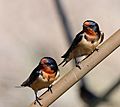Point Pelee National Park facts for kids
Quick facts for kids Point Pelee National Park |
|
|---|---|
|
IUCN Category II (National Park)
|
|

The boardwalk in September 2017
|
|
| Location | Ontario, Canada |
| Nearest city | Leamington, Ontario |
| Area | 15 km2 (5.8 sq mi) |
| Established | 1918 |
| Governing body | Parks Canada |
| Designated: | 27 May 1987 |
Point Pelee National Park, also called Point Pelee, is a special protected area in Ontario, Canada. It's located in Essex County. This park is a unique piece of land shaped like a triangle, sticking out into Lake Erie. It has lots of marshes (wetlands) and forests. Even Middle Island in Lake Erie is part of the park!
Point Pelee is the southernmost tip of mainland Canada. The park is about 7 kilometers long and 4.5 kilometers wide at its widest part. It was created in 1918. This was important because it was the first national park in Canada made to protect nature. Other parks before it were mostly for tourists. Point Pelee also became a Ramsar site in 1987. This means it's a wetland of international importance. In 2006, it became a dark-sky preserve, a place where you can see the stars clearly.
Contents
Park History
The First Nations people of Canada lived on Point Pelee for a very long time. This was before Europeans came to settle the area. People think that a large ancient site found at Point Pelee was used between the years AD 700 and 900. Two priests, Fathers Dollier and Galinee, named Point Pelee in 1670. The word pelée is French for "bald."
Protecting the Park
People who loved nature and hunters wanted to protect Point Pelee. They worried that the many different kinds of birds there needed protection from building development. Before the park was created, a group called the Great Lakes Ornithological Society studied bird migration in the area. In 1915, they suggested that Point Pelee should become a national park. This idea helped change how national parks were created in Canada.
When the park first opened, there were still many cottages, two hotels, farms, and even a school inside its borders. More cottages were built even after the park was created. But after a big economic downturn in 1929, no more land in the park was sold. In the 1920s, there was a plan to build a highway through the park.
Changes Over Time
Starting in the 1960s, many people visited Point Pelee. It became the most visited national park in Canada. In 1963, almost 781,000 people came to the park. Because so many people visited, some of the nature and wildlife were harmed. The Canadian government even thought about removing Point Pelee's national park status because of this.
After the 1980s, the government started protecting the park more strictly. They stopped allowing cars to drive all the way to the tip of the park. Instead, they started a shuttle service to take visitors there. They also began buying all the cottages in the park and removing them. More than 350 buildings were taken down, along with two roads. In 1989, duck hunting was no longer allowed in the park. In 1991, the government began managing the deer population to protect the plants. They have done this a few more times since then.
Recent Events
Point Pelee became Canada's first national park to be a dark-sky preserve in 2006. This means it's a great place to see stars at night. In 2006, strong waves from Lake Erie washed away the tip of the park. But in 2007, the tip reappeared because the water level of Lake Erie went down. The tip of Point Pelee changes each year, sometimes growing longer or shorter. In 2017, a fire in Point Pelee burned about 125 hectares of marshland.
Park Geography
Point Pelee National Park is located in the St. Lawrence Lowlands. It is Canada's second smallest national park, after the Georgian Bay Islands National Park. It is only about 15.64 square kilometers in size. A very large part of the park, about 70%, is marshland and has ponds. The rest of the park, about 21%, is mostly forest. The land around the park is mostly made of till plains. These flat areas were formed during the last Ice Age.
Park Climate
Point Pelee has a humid continental climate. This means it has warm and humid summers and cold winters. The temperatures in the park are affected by Lake Erie, which helps keep them a bit milder.
| Climate data for Point Pelee National Park | |||||||||||||
|---|---|---|---|---|---|---|---|---|---|---|---|---|---|
| Month | Jan | Feb | Mar | Apr | May | Jun | Jul | Aug | Sep | Oct | Nov | Dec | Year |
| Record high °C (°F) | 13.0 (55.4) |
14.5 (58.1) |
22.5 (72.5) |
28.5 (83.3) |
31.5 (88.7) |
33.5 (92.3) |
34.0 (93.2) |
34.5 (94.1) |
31.0 (87.8) |
25.5 (77.9) |
20.6 (69.1) |
18.5 (65.3) |
34.5 (94.1) |
| Mean daily maximum °C (°F) | −0.8 (30.6) |
0.3 (32.5) |
5.0 (41.0) |
11.6 (52.9) |
18.1 (64.6) |
23.6 (74.5) |
26.8 (80.2) |
25.7 (78.3) |
21.6 (70.9) |
15.0 (59.0) |
8.3 (46.9) |
1.9 (35.4) |
13.1 (55.6) |
| Daily mean °C (°F) | −3.9 (25.0) |
−3 (27) |
1.4 (34.5) |
7.4 (45.3) |
13.7 (56.7) |
19.4 (66.9) |
22.4 (72.3) |
21.5 (70.7) |
17.6 (63.7) |
11.4 (52.5) |
5.5 (41.9) |
−0.7 (30.7) |
9.4 (48.9) |
| Mean daily minimum °C (°F) | −6.9 (19.6) |
−6.2 (20.8) |
−2.2 (28.0) |
3.1 (37.6) |
9.3 (48.7) |
15.1 (59.2) |
18.0 (64.4) |
17.2 (63.0) |
13.6 (56.5) |
7.8 (46.0) |
2.6 (36.7) |
−3.3 (26.1) |
5.7 (42.3) |
| Record low °C (°F) | −27.0 (−16.6) |
−24.0 (−11.2) |
−18.0 (−0.4) |
−9.8 (14.4) |
−3.2 (26.2) |
3.0 (37.4) |
7.0 (44.6) |
4.0 (39.2) |
−1.7 (28.9) |
−5.5 (22.1) |
−9.4 (15.1) |
−23.0 (−9.4) |
−27.0 (−16.6) |
| Average precipitation mm (inches) | 57.2 (2.25) |
58.7 (2.31) |
69.9 (2.75) |
75.6 (2.98) |
76.9 (3.03) |
79.8 (3.14) |
83.6 (3.29) |
85.9 (3.38) |
92.7 (3.65) |
69.6 (2.74) |
94.8 (3.73) |
77.4 (3.05) |
922.1 (36.30) |
| Average rainfall mm (inches) | 27.9 (1.10) |
31.3 (1.23) |
51.7 (2.04) |
71.7 (2.82) |
76.9 (3.03) |
79.8 (3.14) |
83.6 (3.29) |
85.9 (3.38) |
92.7 (3.65) |
69.6 (2.74) |
90.9 (3.58) |
56.8 (2.24) |
818.8 (32.24) |
| Average snowfall cm (inches) | 30.5 (12.0) |
27.3 (10.7) |
18.4 (7.2) |
3.8 (1.5) |
0.0 (0.0) |
0.0 (0.0) |
0.0 (0.0) |
0.0 (0.0) |
0.0 (0.0) |
0.06 (0.02) |
3.6 (1.4) |
20.0 (7.9) |
103.8 (40.9) |
| Average precipitation days (≥ 0.2 mm) | 13.4 | 11.4 | 12.8 | 14.7 | 13.3 | 11.7 | 10.9 | 10.1 | 11.7 | 13.5 | 15.3 | 15.4 | 154.4 |
| Average rainy days (≥ 0.2 mm) | 4.7 | 4.9 | 9.0 | 14.0 | 13.3 | 11.7 | 10.9 | 10.1 | 11.7 | 13.5 | 14.2 | 8.9 | 127.1 |
| Average snowy days (≥ 0.2 cm) | 9.2 | 7.1 | 4.7 | 1.3 | 0.0 | 0.0 | 0.0 | 0.0 | 0.0 | 0.15 | 1.7 | 7.5 | 31.6 |
| Source: Environment Canada | |||||||||||||
Images for kids
-
Barn swallows (Hirundo rustica) at Point Peele National Park in May 2010
See also
 In Spanish: Parque nacional Point Pelee para niños
In Spanish: Parque nacional Point Pelee para niños












